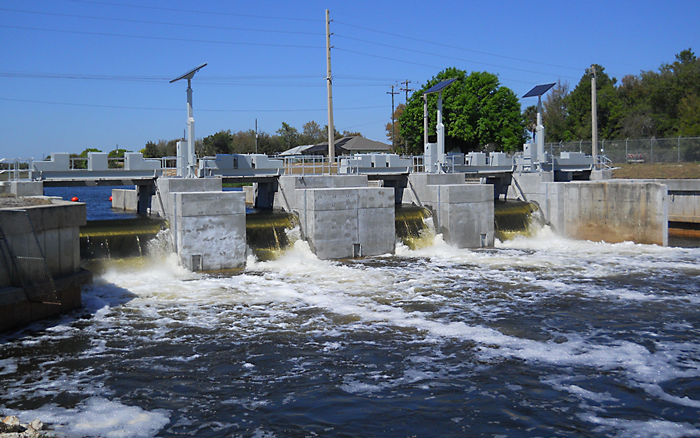


フロリダ州のメルボルン-ティルマン水管理地区 (MTWCD) には、アッパー セント ジョンズ川 (USJR) による洪水から地域を守るための堤防と、排水を改善するための運河ネットワークが含まれています。この排水ネットワークの主要運河は、MTWCD からの雨水をターキー クリークに導き、インディアン リバー ラグーン (IRL) の河口に向かいます。USJR の淡水流量が減少すると、下流のユーザーが利用できる水供給が減少します。また、嵐による淡水流出が IRL に増加したため、塩分濃度が長期間にわたって望ましいレベルを下回る状態が定期的に発生し、IRL 河口の生態系へのストレスが増大しました。関連する汚染により、水柱への光の浸透が弱まり、海草の生息地の被覆率と密度が制限されました。
2010 年、フロリダ州北東部のセントジョンズ川水管理地区 (SJRWMD) は、MTWCD の排水システム改修を後援し、淡水排水システムから IRL への流出を減らす取り組みを行いました。SJRWMD は、老朽化したゲート システムを交換し、以前は東からターキー クリークに流れていた水の一部を西に流して USJR に送りました。
新しい 6 つのゲートは完全に自動化されており、4 つの Campbell Scientific CR1000 データロガーによって制御されています。LoggerNet ソフトウェアを使用して、データロガーはゲートの上流にある 2 つの水位センサーと下流にある 1 つのセンサーを測定するようにプログラムされています。このソフトウェアは MTWCD と SJRWMD オフィスのコンピューターにインストールされ、SJRWMD のラップトップ コンピューターにもインストールされるため、管理者はどこからでもゲートを柔軟に制御できます。ゲートを監視できるように 2 台のカメラが配置されており、データロガーとソフトウェアとインターフェイスして、現場をリモートで監視できます。
Campbell Scientific の装置は、ほとんどの流量および洪水制御状況で自動モードで稼働し、スタッフの介入は最小限で済みます。ゲートのすべての動作 (すべての水位、6 つのゲートの位置、降雨量、その他の要素) は装置によって監視されます。また、LoggerNet ソフトウェアは、ゲートを通過する流量を継続的に計算して報告します。
制御データ ロガーには、ゲート制御とフロー制御という 2 つの基本的な操作方式がプログラムされています。ゲート制御では、オペレーターは 6 つのゲートを任意の高さに設定でき、ゲートは再度移動されるまでその高さに留まります。フロー制御では、オペレーターは任意のフロー値 (たとえば 575 立方フィート/秒 (cfs)) を指定します。LoggerNet システムはゲート フローを常に計算するため、この操作方式では、データ ロガーが希望するフローに基づいてゲートを物理的に移動できます。管理者が必要なときはいつでも、オーバーライドして手動操作に切り替えるオプションを使用できます。
これらの流量制御により、上流の水位に関係なく、システムは C-1 運河からターキー クリークへの排水を制限します。緊急事態が考慮され、システムはオペレーターによって開始されたときに熱帯暴風雨やハリケーンの状況に対応するようにプログラムされています。これらのモードでは、熱帯暴風雨やハリケーンがその地域に近づくにつれて、より多くの流量を通過できるように、任意のカウントダウン (通常は 72 時間) を通じてゲートが徐々に開きます。暴風雨の脅威が去った後、またはカウントダウンのどの時点でも、システムは自動洪水制御モードに切り替えることができます。
すべてのゲートおよび運用変更の主な利点は、上流の運河の水位を上げて必要に応じて水を迂回させることができること、ゲートを通過する排水は、他のタイプのゲートが排水する下層の水よりも酸素含有量が高い、より有利な上層の水であることです (ターキー クリークの水質向上のため)。これらのオーバーシュート ゲートは、排水中の堆積物の輸送と濁度も低減します。これらの改善はすべて、IRL 河口への淡水排水を削減するという最終目標を達成し、インディアン リバー ラグーンへの栄養素やその他の汚染物質の削減につながります。